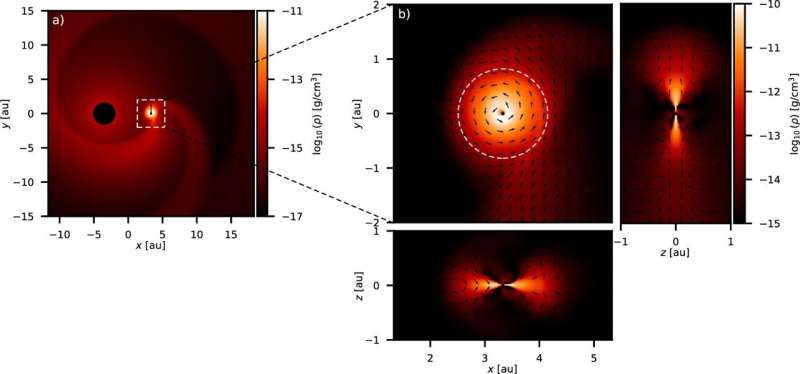Science
ALMA Discovers Companion Orbiting Red Giant Star π 1 Gruis

A team of international scientists has successfully identified a companion star orbiting the red giant star known as π 1 Gruis, located approximately 530 light-years from Earth. Utilizing advanced observational techniques through the Atacama Large Millimeter/submillimeter Array (ALMA) in Chile, the researchers have unveiled significant insights into the dynamics of this celestial system, challenging existing models of stellar evolution.
Unraveling Stellar Mysteries
The red giant star, π 1 Gruis, is classified as an asymptotic giant branch (AGB) star, a stage in stellar evolution characterized by significant changes. Once similar to the sun, π 1 Gruis has expanded to over 400 times the sun’s size and now emits light thousands of times brighter than our sun. This extreme luminosity complicates the detection of any close companion stars, which can easily be outshone.
In a groundbreaking paper published in the journal Nature Astronomy, the team, including Yoshiya Mori, a Ph.D. candidate in astrophysics at Monash University, provided direct observational evidence of the companion’s orbit. Mori highlighted the importance of accurately determining the mass of π 1 Gruis to understand the companion’s influence, stating, “A key part of understanding the orbit of the companion is knowing the mass of the AGB star.”
Revising Stellar Evolution Models
The research presented a notable deviation from previous predictions. While earlier models suggested that the companion star would have an elliptical orbit, observations revealed an almost circular path. This finding implies that the orbital evolution may occur more rapidly than previously understood, prompting a reevaluation of how companions interact with giant stars.
Project lead Mats Esseldeurs from KU Leuven emphasized the broader implications of this discovery. “Understanding how close companions behave under these conditions helps us better predict what will happen to the planets around the sun, and how the companion influences the evolution of the giant star itself,” he said.
The findings suggest that existing models may have underestimated the rates at which orbits circularize. This revelation opens new avenues for research into tidal interactions and the behavior of binary stars, potentially altering our understanding of the life cycles of stars and their companions.
The international collaboration showcases the significance of utilizing sophisticated technology to explore the cosmos. As scientists continue to investigate the complexities of stars like π 1 Gruis, the knowledge gained will enhance our comprehension of stellar life cycles and their implications for planetary systems.
The research, published on November 14, 2025, marks a milestone in astrophysics, offering insights that could reshape established theories and deepen our understanding of the universe. For further details, refer to the publication: Mats Esseldeurs et al, “Evidence for the Keplerian orbit of a close companion around a giant star,” in Nature Astronomy.
-

 Science1 month ago
Science1 month agoIROS 2025 to Showcase Cutting-Edge Robotics Innovations in China
-

 Lifestyle1 month ago
Lifestyle1 month agoStone Island’s Logo Worn by Extremists Sparks Brand Dilemma
-

 Health1 month ago
Health1 month agoStartup Liberate Bio Secures $31 Million for Next-Gen Therapies
-

 Science2 weeks ago
Science2 weeks agoUniversity of Hawaiʻi at Mānoa Joins $25.6M AI Initiative for Disaster Monitoring
-

 World1 month ago
World1 month agoBravo Company Veterans Honored with Bronze Medals After 56 Years
-

 Politics4 weeks ago
Politics4 weeks agoJudge Considers Dismissal of Chelsea Housing Case Citing AI Flaws
-

 Lifestyle1 month ago
Lifestyle1 month agoMary Morgan Jackson Crowned Little Miss National Peanut Festival 2025
-

 Health1 month ago
Health1 month agoTop Hyaluronic Acid Serums for Radiant Skin in 2025
-

 Science1 month ago
Science1 month agoArizona State University Transforms Programming Education Approach
-

 Sports1 month ago
Sports1 month agoYamamoto’s Mastery Leads Dodgers to 5-1 Victory in NLCS Game 2
-

 Top Stories1 month ago
Top Stories1 month agoIndonesia Suspends 27,000 Bank Accounts in Online Gambling Crackdown
-

 Business1 month ago
Business1 month agoTruist Financial Increases Stake in Global X Variable Rate ETF









